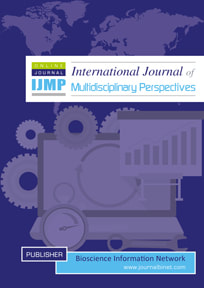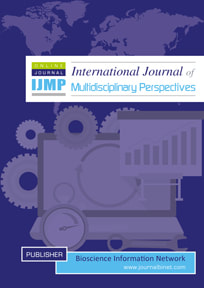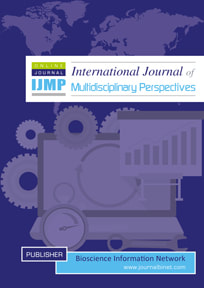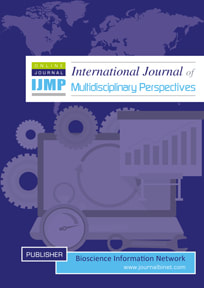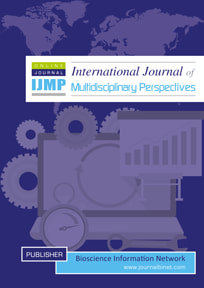International Journal of Multidisciplinary Perspectives
You are here: Home>IJMP Journal>Archive>Volume 03
Volume 03 - Issue 01 | Year of Publication: 2022
Article Type: Research Article | No. 08 | Country: Bangladesh | pp. 50-56 | Open Access
Title: Determinants of demand for reproductive health care by the rural women in Bangladesh: a case study of the selected households from Narshingdi district
Authors: Sarker, M. S. H.
DOI: http://dx.doi.org/10.18801/ijmp.030122.08
Title: Determinants of demand for reproductive health care by the rural women in Bangladesh: a case study of the selected households from Narshingdi district
Authors: Sarker, M. S. H.
DOI: http://dx.doi.org/10.18801/ijmp.030122.08
Determinants of demand for reproductive health care by the rural women in Bangladesh: a case study of the selected households from Narshingdi district
Abstract
The purpose of this study article is to determine the determinants of rural women's desire for reproductive health care from modern institutions in order to determine the level of demand. In light of this, 55 women were questioned. Home birth was 76 percent of the time in 55 cases, and Trained Birth Attendants were present for 20 percent of the time. The use of modern facilities accounted for 40% of deliveries, while traditional methods accounted for 60%. As a result, rural women's demand for reproductive health care (particularly referring delivery services) is low. Economic, social, cultural, and behavioral issues all contributed to the low demand for reproductive health care. However, it has been discovered that there is a significant variation in how the poor and wealthy respond to underlying factors that influence the use of reproductive health care commodities. For the impoverished, economic reasons were critical, but not for the wealthy.
Key Words: Reproductive Health, Economic Condition and Delivery behavior
Abstract
The purpose of this study article is to determine the determinants of rural women's desire for reproductive health care from modern institutions in order to determine the level of demand. In light of this, 55 women were questioned. Home birth was 76 percent of the time in 55 cases, and Trained Birth Attendants were present for 20 percent of the time. The use of modern facilities accounted for 40% of deliveries, while traditional methods accounted for 60%. As a result, rural women's demand for reproductive health care (particularly referring delivery services) is low. Economic, social, cultural, and behavioral issues all contributed to the low demand for reproductive health care. However, it has been discovered that there is a significant variation in how the poor and wealthy respond to underlying factors that influence the use of reproductive health care commodities. For the impoverished, economic reasons were critical, but not for the wealthy.
Key Words: Reproductive Health, Economic Condition and Delivery behavior
MLA
Sarker, M. S. H. "Determinants of demand for reproductive health care by the rural women in Bangladesh: a case study of the selected households from Narshingdi district". International Journal of Multidisciplinary Perspectives, 03(01) (2022): 50-56.
APA
Sarker, M. S. H. (2022). Determinants of demand for reproductive health care by the rural women in Bangladesh: a case study of the selected households from Narshingdi district. International Journal of Multidisciplinary Perspectives, 03(01), 50-56.
Chicago
Sarker, M. S. H. "Determinants of demand for reproductive health care by the rural women in Bangladesh: a case study of the selected households from Narshingdi district". International Journal of Multidisciplinary Perspectives, 03(01) (2022): 50-56.
Harvard
Sarker, M. S. H. 2022. Determinants of demand for reproductive health care by the rural women in Bangladesh: a case study of the selected households from Narshingdi district. International Journal of Multidisciplinary Perspectives, 03(01) pp. 50-56.
Vancouver
Sarker, MSH. Determinants of demand for reproductive health care by the rural women in Bangladesh: a case study of the selected households from Narshingdi district. International Journal of Multidisciplinary Perspectives, 2022 03(01), 50-56.
Sarker, M. S. H. "Determinants of demand for reproductive health care by the rural women in Bangladesh: a case study of the selected households from Narshingdi district". International Journal of Multidisciplinary Perspectives, 03(01) (2022): 50-56.
APA
Sarker, M. S. H. (2022). Determinants of demand for reproductive health care by the rural women in Bangladesh: a case study of the selected households from Narshingdi district. International Journal of Multidisciplinary Perspectives, 03(01), 50-56.
Chicago
Sarker, M. S. H. "Determinants of demand for reproductive health care by the rural women in Bangladesh: a case study of the selected households from Narshingdi district". International Journal of Multidisciplinary Perspectives, 03(01) (2022): 50-56.
Harvard
Sarker, M. S. H. 2022. Determinants of demand for reproductive health care by the rural women in Bangladesh: a case study of the selected households from Narshingdi district. International Journal of Multidisciplinary Perspectives, 03(01) pp. 50-56.
Vancouver
Sarker, MSH. Determinants of demand for reproductive health care by the rural women in Bangladesh: a case study of the selected households from Narshingdi district. International Journal of Multidisciplinary Perspectives, 2022 03(01), 50-56.
Article Type: Research Article | No. 09 | Country: Bangladesh | pp. 57-61 | Open Access
Title: Development of four/five crop-based cropping pattern studies for increasing cropping intensity and productivity
Authors: Kamal, S. M. A. H. M., Hoque, M. O., Sarker, M. B., Masud, M. Z. and Rahman, M. M.
DOI: http://dx.doi.org/10.18801/ijmp.030122.09
Title: Development of four/five crop-based cropping pattern studies for increasing cropping intensity and productivity
Authors: Kamal, S. M. A. H. M., Hoque, M. O., Sarker, M. B., Masud, M. Z. and Rahman, M. M.
DOI: http://dx.doi.org/10.18801/ijmp.030122.09
Development of four/five crop-based cropping pattern studies for increasing cropping intensity and productivity
Abstract
A field trial was initiated from 2014-15 cropping years at RARS, BARI, Burirhat, Rangpur with six cropping patterns like CP1 = Potato - Mungbean - T. Aus rice - T. Aman rice, CP2 = Potato - Lalshak-Mungbean - T. Aus rice - T. Aman rice, CP3 = Mustard - Lalshak - Mungbean-T. Aus rice - T. Aman rice, CP4 = Gardenpea - Boro rice -T. Aus rice -T. Aman rice, CP5 = Gardenpea - Lalshak -Mungbean-T. Aus rice - T. Aman rice and CP6 = Fallow - Boro rice - Fallow - T. Aman rice (Farmers practice) to increase cropping intensity, sustain food security, poverty reduction etc.. The highest rice equivalent yield (32.34 t ha-1 in 2014-15, 33.44 t ha-1 in 2015-16 and 32.26 t ha-1 in 2016-17) was found in CP2 cropping pattern, followed by CP1 (26.79 t ha-1 in 2014-15, 26.32 t ha-1 in 2015-16 and 27.10 t ha-1 in 2016-17), CP5 (26.74 t ha-1 in 2014-15, 26.21 t ha-1 in 2015-16 and 25.60 t ha-1 in 2016-17) and others. The highest gross margin Tk. 228025/- ha-1 in 2014-15 Tk. and 234355/- ha-1 in 2015-16 and Tk. 211495/- in 2016-17 was obtained from CP5 and CP2 cropping patterns, respectively. The highest cost ratio 2.42, 2.38 and 2.32 was recorded from the CP5 cropping pattern in 2014-15, 2015-16 and 2016-17 cropping years respectively, followed by CP2. Always the lowest was in CP6 cropping patterns. So, CP5 and CP2 were compared to better cropping patterns to recommend practice for farmers in this region.
Key Words: Cropping pattern, Cropping intensity, Rice, Productivity and Crop
Abstract
A field trial was initiated from 2014-15 cropping years at RARS, BARI, Burirhat, Rangpur with six cropping patterns like CP1 = Potato - Mungbean - T. Aus rice - T. Aman rice, CP2 = Potato - Lalshak-Mungbean - T. Aus rice - T. Aman rice, CP3 = Mustard - Lalshak - Mungbean-T. Aus rice - T. Aman rice, CP4 = Gardenpea - Boro rice -T. Aus rice -T. Aman rice, CP5 = Gardenpea - Lalshak -Mungbean-T. Aus rice - T. Aman rice and CP6 = Fallow - Boro rice - Fallow - T. Aman rice (Farmers practice) to increase cropping intensity, sustain food security, poverty reduction etc.. The highest rice equivalent yield (32.34 t ha-1 in 2014-15, 33.44 t ha-1 in 2015-16 and 32.26 t ha-1 in 2016-17) was found in CP2 cropping pattern, followed by CP1 (26.79 t ha-1 in 2014-15, 26.32 t ha-1 in 2015-16 and 27.10 t ha-1 in 2016-17), CP5 (26.74 t ha-1 in 2014-15, 26.21 t ha-1 in 2015-16 and 25.60 t ha-1 in 2016-17) and others. The highest gross margin Tk. 228025/- ha-1 in 2014-15 Tk. and 234355/- ha-1 in 2015-16 and Tk. 211495/- in 2016-17 was obtained from CP5 and CP2 cropping patterns, respectively. The highest cost ratio 2.42, 2.38 and 2.32 was recorded from the CP5 cropping pattern in 2014-15, 2015-16 and 2016-17 cropping years respectively, followed by CP2. Always the lowest was in CP6 cropping patterns. So, CP5 and CP2 were compared to better cropping patterns to recommend practice for farmers in this region.
Key Words: Cropping pattern, Cropping intensity, Rice, Productivity and Crop
MLA
Kamal, S. M. A. H. M. et al. “Development of four/five crop-based cropping pattern studies for increasing cropping intensity and productivity”. International Journal of Multidisciplinary Perspectives, 03(01) (2022): 57-61.
APA
Kamal, S. M. A. H. M., Hoque, M. O., Sarker, M. B., Masud, M. Z. and Rahman, M. M. (2022). Development of four/five crop-based cropping pattern studies for increasing cropping intensity and productivity. International Journal of Multidisciplinary Perspectives, 03(01), 57-61.
Chicago
Kamal, S. M. A. H. M., Hoque, M. O., Sarker, M. B., Masud, M. Z. and Rahman, M. M. “Development of four/five crop-based cropping pattern studies for increasing cropping intensity and productivity”. International Journal of Multidisciplinary Perspectives, 03(01) (2022): 57-61.
Harvard
Kamal, S. M. A. H. M., Hoque, M. O., Sarker, M. B., Masud, M. Z. and Rahman, M. M. 2022. Development of four/five crop-based cropping pattern studies for increasing cropping intensity and productivity. International Journal of Multidisciplinary Perspectives, 03(01), pp. 57-61.
Vancouver
Kamal SMAHM, Hoque MO, Sarker MB, Masud MZ and Rahman MM (2022). Development of four/five crop-based cropping pattern studies for increasing cropping intensity and productivity. International Journal of Multidisciplinary Perspectives, 2022 July 03(01): 57-61.
Kamal, S. M. A. H. M. et al. “Development of four/five crop-based cropping pattern studies for increasing cropping intensity and productivity”. International Journal of Multidisciplinary Perspectives, 03(01) (2022): 57-61.
APA
Kamal, S. M. A. H. M., Hoque, M. O., Sarker, M. B., Masud, M. Z. and Rahman, M. M. (2022). Development of four/five crop-based cropping pattern studies for increasing cropping intensity and productivity. International Journal of Multidisciplinary Perspectives, 03(01), 57-61.
Chicago
Kamal, S. M. A. H. M., Hoque, M. O., Sarker, M. B., Masud, M. Z. and Rahman, M. M. “Development of four/five crop-based cropping pattern studies for increasing cropping intensity and productivity”. International Journal of Multidisciplinary Perspectives, 03(01) (2022): 57-61.
Harvard
Kamal, S. M. A. H. M., Hoque, M. O., Sarker, M. B., Masud, M. Z. and Rahman, M. M. 2022. Development of four/five crop-based cropping pattern studies for increasing cropping intensity and productivity. International Journal of Multidisciplinary Perspectives, 03(01), pp. 57-61.
Vancouver
Kamal SMAHM, Hoque MO, Sarker MB, Masud MZ and Rahman MM (2022). Development of four/five crop-based cropping pattern studies for increasing cropping intensity and productivity. International Journal of Multidisciplinary Perspectives, 2022 July 03(01): 57-61.
Article Type: Research Article | No. 10 | Country: Bangladesh | pp. 62-67 | Open Access
Title: Impact of organic manures on progression of common scab and potato yield
Authors: Saha, A. K., Haque, M. E., Rashid, M. H., Rahman, M. M. E. and Naher, N.
DOI: http://dx.doi.org/10.18801/ijmp.030122.10
Title: Impact of organic manures on progression of common scab and potato yield
Authors: Saha, A. K., Haque, M. E., Rashid, M. H., Rahman, M. M. E. and Naher, N.
DOI: http://dx.doi.org/10.18801/ijmp.030122.10
Impact of organic manures on progression of common scab and potato yield
Abstract
There were five different organic matter (Mustard oil cake, Neem oil cake, Poultry refuse, Annapurna jaibo sar and Cow dung) and their different doses were evaluated over control (only chemical fertilizers) against common scab disease of potato in heavily common scab infested sandy loam soil in Rangpur sadar, Rangpur during 2008-09 and 2009-10 cropping season. The initial pH of that soil was 5.3. Susceptible potato variety (Diamant) was considered in this study. All organic fertilizers except cow dung significantly reduced disease incidence and severity over control treatment (chemical fertilizer) in both cropping seasons. The lowest disease incidence (8.88% and 7.25% in 2008-2009 and 2009-2010, respectively) and severity index i.e., percent disease index (1.97 and 1.65 in 2008-2009 and 2009-2010, respectively) were found in Annapurna Jaibo sar used plots. The significantly highest disease incidence (24.44% and 28.99% in 2008-2009 and 2009-2010, respectively) and severity index (7.23 and 8.30 in 2008-2009 and 2009-2010, respectively) were recorded in cow dung used plots. For tuber yield, organic matters were not significantly different from each other but differed significantly with only chemical fertilizer used treatment. Annapurna jaibo sar yielded the highest in both cropping seasons. The highest yield was 28.82 t ha-1 and 27.76 t ha-1 in 2008-2009 and 2009-2010 cropping seasons, respectively. A higher dose of each organic amendment was observed to be more effective for managing common scab and increasing yield.
Key words: Common scab, Disease incidence, Disease severity, Percent Disease Severity (PDI), Mustard oil cake, Neem oil cake, Poultry refuse, Annapurna jaibo sar and Cow dung
Abstract
There were five different organic matter (Mustard oil cake, Neem oil cake, Poultry refuse, Annapurna jaibo sar and Cow dung) and their different doses were evaluated over control (only chemical fertilizers) against common scab disease of potato in heavily common scab infested sandy loam soil in Rangpur sadar, Rangpur during 2008-09 and 2009-10 cropping season. The initial pH of that soil was 5.3. Susceptible potato variety (Diamant) was considered in this study. All organic fertilizers except cow dung significantly reduced disease incidence and severity over control treatment (chemical fertilizer) in both cropping seasons. The lowest disease incidence (8.88% and 7.25% in 2008-2009 and 2009-2010, respectively) and severity index i.e., percent disease index (1.97 and 1.65 in 2008-2009 and 2009-2010, respectively) were found in Annapurna Jaibo sar used plots. The significantly highest disease incidence (24.44% and 28.99% in 2008-2009 and 2009-2010, respectively) and severity index (7.23 and 8.30 in 2008-2009 and 2009-2010, respectively) were recorded in cow dung used plots. For tuber yield, organic matters were not significantly different from each other but differed significantly with only chemical fertilizer used treatment. Annapurna jaibo sar yielded the highest in both cropping seasons. The highest yield was 28.82 t ha-1 and 27.76 t ha-1 in 2008-2009 and 2009-2010 cropping seasons, respectively. A higher dose of each organic amendment was observed to be more effective for managing common scab and increasing yield.
Key words: Common scab, Disease incidence, Disease severity, Percent Disease Severity (PDI), Mustard oil cake, Neem oil cake, Poultry refuse, Annapurna jaibo sar and Cow dung
MLA
Saha, A. K. et al. “Impact of organic manures on progression of common scab and potato yield”. International Journal of Multidisciplinary Perspectives, 03(01) (2022): 62-67.
APA
Saha, A. K., Haque, M. E., Rashid, M. H., Rahman, M. M. E. and Naher, N. (2022). Impact of organic manures on progression of common scab and potato yield. International Journal of Multidisciplinary Perspectives, 03(01), 62-67.
Chicago
Saha, A. K., Haque, M. E., Rashid, M. H., Rahman, M. M. E. and Naher, N. “Impact of organic manures on progression of common scab and potato yield”. International Journal of Multidisciplinary Perspectives, 03(01) (2022): 62-67.
Harvard
Saha, A. K., Haque, M. E., Rashid, M. H., Rahman, M. M. E. and Naher, N. 2022. Impact of organic manures on progression of common scab and potato yield. International Journal of Multidisciplinary Perspectives, 03(01), pp. 62-67.
Vancouver
Saha, AK, Haque, ME, Rashid, MH, Rahman, MME and Naher N. Impact of organic manures on progression of common scab and potato yield. International Journal of Multidisciplinary Perspectives, 2022 December 03(01), 62-67.
Saha, A. K. et al. “Impact of organic manures on progression of common scab and potato yield”. International Journal of Multidisciplinary Perspectives, 03(01) (2022): 62-67.
APA
Saha, A. K., Haque, M. E., Rashid, M. H., Rahman, M. M. E. and Naher, N. (2022). Impact of organic manures on progression of common scab and potato yield. International Journal of Multidisciplinary Perspectives, 03(01), 62-67.
Chicago
Saha, A. K., Haque, M. E., Rashid, M. H., Rahman, M. M. E. and Naher, N. “Impact of organic manures on progression of common scab and potato yield”. International Journal of Multidisciplinary Perspectives, 03(01) (2022): 62-67.
Harvard
Saha, A. K., Haque, M. E., Rashid, M. H., Rahman, M. M. E. and Naher, N. 2022. Impact of organic manures on progression of common scab and potato yield. International Journal of Multidisciplinary Perspectives, 03(01), pp. 62-67.
Vancouver
Saha, AK, Haque, ME, Rashid, MH, Rahman, MME and Naher N. Impact of organic manures on progression of common scab and potato yield. International Journal of Multidisciplinary Perspectives, 2022 December 03(01), 62-67.
Volume 03 - Issue 02 | Year of Publication: 2022
Article Type: Research Article | No. 11 | Country: Bangladesh | pp. 68-73 | Open Access
Title: Effect of seedling age at transplants on growth, yield and seed production of sweet pepper in Bangladesh
Authors: Ahmed, Q. M., Roy, S., Hoque, A. K. M. A., Jahan, N., Khatun, F. M. and Hossain, M. M.
DOI: http://dx.doi.org/10.18801/ijmp.030222.11
Title: Effect of seedling age at transplants on growth, yield and seed production of sweet pepper in Bangladesh
Authors: Ahmed, Q. M., Roy, S., Hoque, A. K. M. A., Jahan, N., Khatun, F. M. and Hossain, M. M.
DOI: http://dx.doi.org/10.18801/ijmp.030222.11
Effect of seedling age at transplants on growth, yield and seed production of sweet pepper in Bangladesh
Abstract
Recently, sweet pepper (Capsicum spp.) has been a commercially important crop in Bangladesh. The cultivation procedure is highly sensitive to different environments. In the case of quality production, appropriate seedling age is a prerequisite for higher yield. The experiment was carried out at the Regional Horticulture Research Station, Bangladesh Agricultural Research Institute, Shibpur, Narsingdi, Bangladesh during the Rabi season of 2017-2018. Six treatments were used i.e.,. 14 days, 21 days, 28 days, 35 days, 42 days and 48 days at the age of transplanting seedlings. The experiment was conducted in a randomized complete block design with three replications. The number of seeds per fruit and thousand seeds weights resulted better at 21 days, 28 days and 35 days the age of transplanting seedlings. Considering marketable fruit number (13.55), yield per plant (1.69 kg) and yield (26.80 t ha-1) was found at 28 days’ age of transplant seedling, which was followed by 35 days’ age of transplant seedling. The lowest yield per plant (0.49 kg) and yield (7.76 t ha-1) were recorded at 48 days age of transplant seedling, respectively. From the result of this experiment, it may be recommended that 28 days’ age of seedling at transplant growth, yield and seed production showed better performance than other ages of seedlings at transplants of BARI Mistimorich-1.
Key Words: Capsicum, Transplanting, Growth, Production and Yield.
Abstract
Recently, sweet pepper (Capsicum spp.) has been a commercially important crop in Bangladesh. The cultivation procedure is highly sensitive to different environments. In the case of quality production, appropriate seedling age is a prerequisite for higher yield. The experiment was carried out at the Regional Horticulture Research Station, Bangladesh Agricultural Research Institute, Shibpur, Narsingdi, Bangladesh during the Rabi season of 2017-2018. Six treatments were used i.e.,. 14 days, 21 days, 28 days, 35 days, 42 days and 48 days at the age of transplanting seedlings. The experiment was conducted in a randomized complete block design with three replications. The number of seeds per fruit and thousand seeds weights resulted better at 21 days, 28 days and 35 days the age of transplanting seedlings. Considering marketable fruit number (13.55), yield per plant (1.69 kg) and yield (26.80 t ha-1) was found at 28 days’ age of transplant seedling, which was followed by 35 days’ age of transplant seedling. The lowest yield per plant (0.49 kg) and yield (7.76 t ha-1) were recorded at 48 days age of transplant seedling, respectively. From the result of this experiment, it may be recommended that 28 days’ age of seedling at transplant growth, yield and seed production showed better performance than other ages of seedlings at transplants of BARI Mistimorich-1.
Key Words: Capsicum, Transplanting, Growth, Production and Yield.
MLA
Ahmed, Q. M. et al. “Effect of seedling age at transplants on growth, yield and seed production of sweet pepper in Bangladesh”. International Journal of Multidisciplinary Perspectives, 03(02) (2022): 68-73.
APA
Ahmed, Q. M., Roy, S., Hoque, A. K. M. A., Jahan, N., Khatun, F. M. and Hossain, M. M. (2022). Effect of seedling age at transplants on growth, yield and seed production of sweet pepper in Bangladesh. International Journal of Multidisciplinary Perspectives, 03(02), 68-73.
Chicago
Ahmed, Q. M., Roy, S., Hoque, A. K. M. A., Jahan, N., Khatun, F. M. and Hossain, M. M. “Effect of seedling age at transplants on growth, yield and seed production of sweet pepper in Bangladesh”. International Journal of Multidisciplinary Perspectives, 03(02) (2022): 68-73.
Harvard
Ahmed, Q. M., Roy, S., Hoque, A. K. M. A., Jahan, N., Khatun, F. M. and Hossain, M. M. 2022 Effect of seedling age at transplants on growth, yield and seed production of sweet pepper in Bangladesh. International Journal of Multidisciplinary Perspectives, 03(02), pp. 68-73.
Vancouver
Ahmed, QM, Roy, S, Hoque, AKMA, Jahan, N., Khatun, FM and Hossain, MM. Effect of seedling age at transplants on growth, yield and seed production of sweet pepper in Bangladesh. International Journal of Multidisciplinary Perspectives, 2022 December 03(02), 68-73.
Ahmed, Q. M. et al. “Effect of seedling age at transplants on growth, yield and seed production of sweet pepper in Bangladesh”. International Journal of Multidisciplinary Perspectives, 03(02) (2022): 68-73.
APA
Ahmed, Q. M., Roy, S., Hoque, A. K. M. A., Jahan, N., Khatun, F. M. and Hossain, M. M. (2022). Effect of seedling age at transplants on growth, yield and seed production of sweet pepper in Bangladesh. International Journal of Multidisciplinary Perspectives, 03(02), 68-73.
Chicago
Ahmed, Q. M., Roy, S., Hoque, A. K. M. A., Jahan, N., Khatun, F. M. and Hossain, M. M. “Effect of seedling age at transplants on growth, yield and seed production of sweet pepper in Bangladesh”. International Journal of Multidisciplinary Perspectives, 03(02) (2022): 68-73.
Harvard
Ahmed, Q. M., Roy, S., Hoque, A. K. M. A., Jahan, N., Khatun, F. M. and Hossain, M. M. 2022 Effect of seedling age at transplants on growth, yield and seed production of sweet pepper in Bangladesh. International Journal of Multidisciplinary Perspectives, 03(02), pp. 68-73.
Vancouver
Ahmed, QM, Roy, S, Hoque, AKMA, Jahan, N., Khatun, FM and Hossain, MM. Effect of seedling age at transplants on growth, yield and seed production of sweet pepper in Bangladesh. International Journal of Multidisciplinary Perspectives, 2022 December 03(02), 68-73.
Article Type: Research Article | No. 12 | Country: Bangladesh | pp. 74-81 | Open Access
Title: Homestead tree species diversity: An inventory by secondary school students in Mymensingh, Bangladesh
Authors: Abdullah, M. R., Molla, M. K. A., Jahan, N., Rabbani, A. K. M. G., Barman, S. C. and Jahan, R.
DOI: http://dx.doi.org/10.18801/ijmp.030222.12
Title: Homestead tree species diversity: An inventory by secondary school students in Mymensingh, Bangladesh
Authors: Abdullah, M. R., Molla, M. K. A., Jahan, N., Rabbani, A. K. M. G., Barman, S. C. and Jahan, R.
DOI: http://dx.doi.org/10.18801/ijmp.030222.12
Homestead tree species diversity: An inventory by secondary school students in Mymensingh, Bangladesh
Abstract
Continued loss of forest vegetation in Bangladesh's national forests and protected areas poses a threat to forest productivity and biodiversity due to human population growth and other biotic and abiotic factors. An inventory was conducted by the students of Jagir Uddin High school of Muktagacha upazila Mymensingh district, Bangladesh with an objectives to quantify the tree species diversity of their homestead areas. The study was conducted with during the period of 2021. A total of 159 students were involved with this studies. 3959 individuals belongs to 38 types of tree species were was recorded by the students from 11 villages those were belongs to 33 genera and 20 families. Areca catechu (Supari), Mangifera indica (Mango) and Acacia auriculiformis (Akashmoni) constituted the major floral composition. Species diversity of the survey area was 2.5. In all of the locations studied, horticulture plants were more numerous than timber species. However, there is a noticeable uptick in the number of timber species among the newly planted homestead plants. This pattern of floral dynamics suggests that the make-up of homestead plants will likely shift in the not-too-distant future. The results of this study show that there is a great deal of plant diversity in Bangladesh's homestead forests, despite their sparse distribution.
Key Words: Bangladesh, Homestead forests, Shannon–Weaver index, Simpson index and Plant diversity
Abstract
Continued loss of forest vegetation in Bangladesh's national forests and protected areas poses a threat to forest productivity and biodiversity due to human population growth and other biotic and abiotic factors. An inventory was conducted by the students of Jagir Uddin High school of Muktagacha upazila Mymensingh district, Bangladesh with an objectives to quantify the tree species diversity of their homestead areas. The study was conducted with during the period of 2021. A total of 159 students were involved with this studies. 3959 individuals belongs to 38 types of tree species were was recorded by the students from 11 villages those were belongs to 33 genera and 20 families. Areca catechu (Supari), Mangifera indica (Mango) and Acacia auriculiformis (Akashmoni) constituted the major floral composition. Species diversity of the survey area was 2.5. In all of the locations studied, horticulture plants were more numerous than timber species. However, there is a noticeable uptick in the number of timber species among the newly planted homestead plants. This pattern of floral dynamics suggests that the make-up of homestead plants will likely shift in the not-too-distant future. The results of this study show that there is a great deal of plant diversity in Bangladesh's homestead forests, despite their sparse distribution.
Key Words: Bangladesh, Homestead forests, Shannon–Weaver index, Simpson index and Plant diversity
MLA
Abdullah, M. R. et al. “Homestead tree species diversity: An inventory by secondary school students in Mymensingh”. International Journal of Multidisciplinary Perspectives, 03(02) (2022): 74-81.
APA
Abdullah, M. R., Molla, M. K. A., Jahan, N., Rabbani, A. K. M. G., Barman, S. C. and Jahan, R. (2022). Homestead tree species diversity: An inventory by secondary school students in Mymensingh. International Journal of Multidisciplinary Perspectives, 03(02), 74-81.
Chicago
Abdullah, M. R., Molla, M. K. A., Jahan, N., Rabbani, A. K. M. G., Barman, S. C. and Jahan, R. “Effect of seedling age at transplants on growth, yield and seed production of sweet pepper in Bangladesh”. International Journal of Multidisciplinary Perspectives, 03(02) (2022): 74-81.
Harvard
Abdullah, M. R., Molla, M. K. A., Jahan, N., Rabbani, A. K. M. G., Barman, S. C. and Jahan, R. 2022. Homestead tree species diversity: An inventory by secondary school students in Mymensingh. International Journal of Multidisciplinary Perspectives, 03(02), pp. 74-81.
Vancouver
Abdullah, MR, Molla, MKA, Jahan, N, Rabbani, AKMG, Barman, SC and Jahan, R. Homestead tree species diversity: An inventory by secondary school students in Mymensingh. International Journal of Multidisciplinary Perspectives, 2022 December 03(02), 74-81.
Abdullah, M. R. et al. “Homestead tree species diversity: An inventory by secondary school students in Mymensingh”. International Journal of Multidisciplinary Perspectives, 03(02) (2022): 74-81.
APA
Abdullah, M. R., Molla, M. K. A., Jahan, N., Rabbani, A. K. M. G., Barman, S. C. and Jahan, R. (2022). Homestead tree species diversity: An inventory by secondary school students in Mymensingh. International Journal of Multidisciplinary Perspectives, 03(02), 74-81.
Chicago
Abdullah, M. R., Molla, M. K. A., Jahan, N., Rabbani, A. K. M. G., Barman, S. C. and Jahan, R. “Effect of seedling age at transplants on growth, yield and seed production of sweet pepper in Bangladesh”. International Journal of Multidisciplinary Perspectives, 03(02) (2022): 74-81.
Harvard
Abdullah, M. R., Molla, M. K. A., Jahan, N., Rabbani, A. K. M. G., Barman, S. C. and Jahan, R. 2022. Homestead tree species diversity: An inventory by secondary school students in Mymensingh. International Journal of Multidisciplinary Perspectives, 03(02), pp. 74-81.
Vancouver
Abdullah, MR, Molla, MKA, Jahan, N, Rabbani, AKMG, Barman, SC and Jahan, R. Homestead tree species diversity: An inventory by secondary school students in Mymensingh. International Journal of Multidisciplinary Perspectives, 2022 December 03(02), 74-81.

